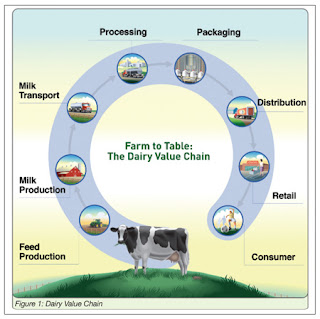As the population's spending power rises, demand for milk and other value-added
milk products is only likely to grow in the coming years. There has to be a
marked change from the unorganized to the organized sector to satisfy the
rising demand. In addition, consumers today not only have greater purchasing
power, but are also conscious of what they consume in terms of health. There is
also a need to provide safe dairy products that can be readily consumed. This
creates an opportunity for boutique dairy farms to set up local operations
providing fresh cow, buffalo or goats milk to consumers. Over and above with
people having less time these days, the demand for premium value-added products
such as probiotic yoghurt, cheese, health shakes etc. are on the rise. Not only
can these goods offer a larger margin, but they also have a higher shelf life,
making the supply chain easier but more cost-efficient.
In India, there are different levels of metrics involved in this supply chain process. The first step is to identify the supply of dairy inputs in the form of grain, animal feed plants, animal veterinary aids (cattle and buffalo), dairy farms (large, medium and small-scale farms), milk collection centers (different milk cooperative societies) for the supply of dairy inputs. Milk collected by cooperative societies is sent to dairy plants where milk is frozen, milk and milk products are processed and packed, milk and milk products are transported from one location to another by refrigerated vans or private, government and cooperative vans of insulated milk tankers. Final processed milk and milk products are shipped to various retail stores, pharmacies and retail markets from which processed milk and milk products ultimately reach their end consumers, such as Nuanced payment rationale to suppliers based on fat, solid non-fat (SNF) and the consistency of milk obtained and monitored by truck and tanker routes, as well as capability.
Manual and time-consuming
processes for measuring milk standardization, handling production planning
based on non-standard raw materials, addressing increasing consumer food issues
are some of the problems and challenges that arise during the production and
standardization period. Fat accounting and effective fat loss tracking in the
course of production, etc. And there are still many concerns and issues facing
this sector of the milk supply chain. Issues may emerge from the level of
operation of the retailer, the level of collection site, the level of storage
and logistic stage, co-operative level & marketing levels.
There are risks / challenges for
the future survival of the extraordinarily aggressive Indian dairy industry in
the global dairy market. Extension is critical for the future growth of the
dairy sector. The growth of the Indian dairy industry is attributed to
ancillary improvements made with the arrival of dairy cooperatives.
The milk industry in India is forecasted
to hit INR 16,368 billion in 2022, with a Compound Annual Growth Rate (CAGR) of
16 percent. In India, usage is mostly skewed towards customary goods.
Interestingly, the largest share of the aggregate milk produced in the nation
is buffalo milk. Because as opposed to cow's milk, net sales are high. Although
it is one of the world's largest milk production countries, India accounts for
a marginal share of the world 's milk trade. In global economies, several
restrictions limit competition. In the near future, the ever-increasing
increase in domestic demand for milk products and a broad demand-supply gap
could lead India to become a net importer of milk products.






No comments:
Post a Comment